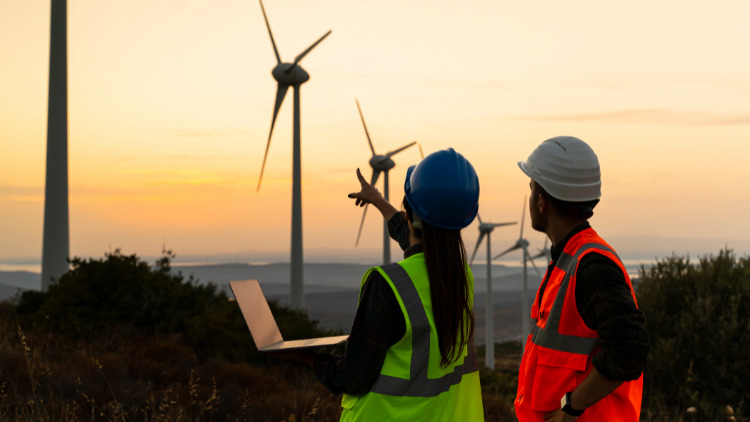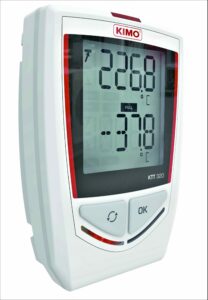06 Oct 2023
Measuring instruments for renewable energies

Climate change is a defining feature of our times, bringing with it a host of challenges and problems. Their many impacts have in some way forced our society to find solutions to address them. Renewable energies are a fine example of innovations that are making a positive contribution to the environment, and are steadily gaining in popularity.
But what is renewable energy?
There are several types of renewable energy. They include solar, wind, hydraulic, geothermal and biomass for example. All these energies are characterized by the fact that they are extremely sustainable, since they are inexhaustible, and offer a number of advantages. These include reducing greenhouse gas emissions, since renewable energies produce far fewer greenhouse gases than fossil fuels (oil, natural gas, coal). They therefore make a major contribution to the fight against climate change, thanks to their clean, renewable nature. What's more, since renewable energies are expanding, many new jobs are constantly being created to meet the growing need for their development and use.
What measuring instruments are used for renewable energies?
You may be wondering what measuring instruments have to do with renewable energies. Many measuring instruments are used in this field, for a variety of reasons and applications. They contribute to data collection, system monitoring, performance analysis and much more. There are many measuring instruments used in the field of renewable energies, but here are just a few that you'll find in our online store:
Anemometers

Sauermann's AVM440
Anemometers are measuring instruments used to measure wind speed, and are therefore very popular in the field of renewable energy, particularly wind power. Anemometers are used to better determine the location of wind turbines, to forecast energy production in order to better integrate them into the electrical grid, to ensure the safe operation of wind turbines and, finally, to evaluate their performance.
As previously mentioned, anemometers are used to collect data such as wind speed and direction at different heights. At the same time, this data is used to determine the best locations for wind turbines. In this way, the data collected by anemometers also contributes to the safe operation of wind turbines; if the winds are too strong and the turbines are operating at too high a speed, the data observed by the anemometers will help determine the correct course of action. Furthermore, the data collected by anemometers can be used to compare wind speed with energy production, enabling operators to prevent potential problem situations (breakdowns, failures, etc.).
Energy sensors
Energy sensors are used to measure the production of energy from renewable sources such as solar, wind, hydro, geothermal or biomass. The data captured can be used to monitor the amount of energy produced at any given time, and to ensure that systems are operating optimally.
Since weather conditions have a major impact on the production of renewable energies, sensors play a vital role in energy production and management. Solar panels, for example, can track and determine the best angle of exposure to the sun's rays for maximum yield.
Energy sensors can also detect anomalies and failures in renewable energy systems, while helping to ensure power grid stability and energy distribution.
On another note, sensors also come in handy for users of renewable energy appliances, enabling them to accurately measure the amount of energy produced and consumed. Needless to say, this greatly simplifies the billing process and the monitoring of system performance.
In short, energy sensors are essential for monitoring, optimizing, maintaining and effectively integrating renewable energy sources into our energy systems, thus contributing to a more sustainable and efficient use of these resources.
Data loggers
Data acquirers are very useful for renewable energies, as they facilitate the collection, storage, analysis and management of data linked to renewable energy production systems.
In particular, they enable real-time monitoring of the performance of renewable energy production facilities, such as solar panels, wind turbines or hydroelectric power plants. In particular, they collect data on energy production and consumption, weather conditions, voltage and current. All this data is then used to optimize renewable energy production and ensure preventive system maintenance.
The data collected by data loggers provides a better understanding of energy requirements, making it easier to manage demand. For example, the data can help plan the charging of energy storage batteries to meet needs during periods of low renewable energy production. Data collectors also generate detailed reports and analyses of the performance of renewable energy production systems. This is invaluable for assessing the efficiency, profitability and sustainability of the installations in question.
In short, data loggers are essential for monitoring, optimizing, maintaining, integrating and managing renewable energy systems.
Pressure gauges
Pressure gauges are devices used to measure the pressure of a fluid or gas, making them particularly useful in the field of hydropower. Among other things, they can be used to monitor pressure in hydroelectric power stations, helping to ensure that the systems are running smoothly and that hydroelectric power is being produced as efficiently as possible.
The use of pressure gauges can also prove useful in detecting leaks or potential problem situations. Indeed, the data collected can contribute to the preventive maintenance of systems by detecting an unexpected change in pressure, for example. As the measurements obtained are precise, they can be relied upon and acted upon accordingly.
In addition to these applications, pressure gauges are also very useful in the field of electromobility, for example. The lithium-ion batteries used in electric cars come to mind; pressure gauges can be used to monitor their internal pressure, which can rise in the event of overheating or failure.
Even if these are just a few examples, it's fair to say that measuring instruments are very useful in the field of renewable energies. At Chevrier Instruments, we have everything you need in the way of measuring instruments, from pressure gauges and data sensors to more specific instruments - we're your reference!


